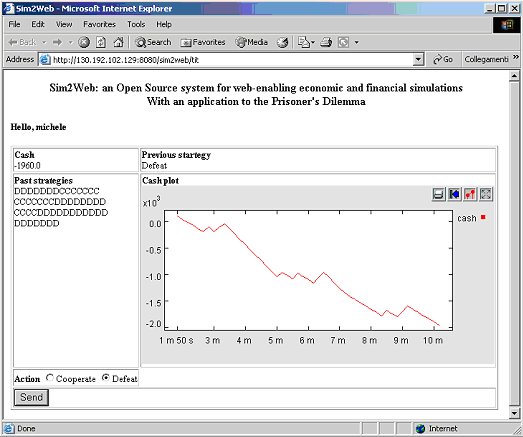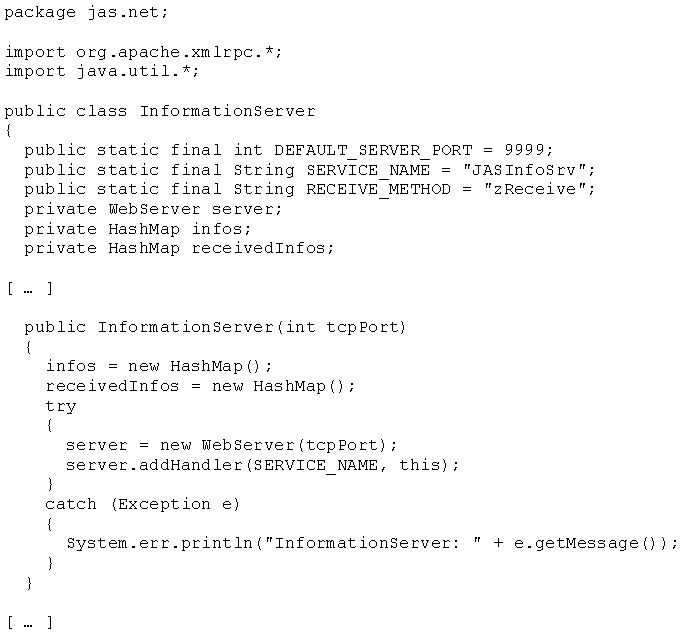Sergio Margarita and Michele Sonnessa (2003)
Sim2Web: an Open Source system for web-enabling economic and financial simulations
Journal of Artificial Societies and Social Simulation
vol. 6, no. 4
To cite articles published in the Journal of Artificial Societies and Social Simulation, please reference the above information and include paragraph numbers if necessary
<https://www.jasss.org/6/4/12.html>
Received: 8-Mar-2003 Accepted: 13-Oct-2003 Published: 31-Oct-2003
 Abstract
Abstract

|
| Figure 1. The three-tier structure of Sim2Web. |
ID: the name of the function called in the web page
Title: a description of the function (optional)
Module name: the name of the Python module (without the .py extension)
Function name: the name of the function within the Python module.
| Table 1: Zope and Python methods. | ||
| ID | Module name | Function name |
| ZAsk | sim2web | zAsk |
| ZDisplayText | sim2web | zDisplayText |
| ZDisplaySVG | sim2web | zDisplaySVG |
| ZTransmit | sim2web | zTransmit |
| Table 1: Payoff matrix | |||
| What other does | |||
| Cooperates | Defects | ||
| What you do | Cooperate | You get 2 years The other gets 2 years | You take 3 years The other gets 0 years |
| Defect | You get 0 years The other gets 3 years | You take 1 year The other gets 1 year | |
server.addInfo(bug.getName(), "id01", "Cash: " + bug.getCash());

|
| Figure 2. Sequence diagram of the TitForTat model |

|
| Figure 3. Zope: the GUI for playing Prisoner's Dilemma simulation. |

BEEHIVE (2001) The Book of Zope, No Starch Press.
BELTRATTI A, MARGARITA S and TERNA P (1996) Neural Networks for Economic and Financial Modelling, Thomson Computer Press.
CAGLE K and BIERMAN M (2002), SVG Programming, APress.
EISENBERG JD (2002) SVG Essentials, O'Reilly & Associates.
HOFSTADTER DR (1983) Metamagical Themas: Computer Tournaments of the Prisoner's Dilemma Suggest How Cooperation Evolves, Scientific American 248 (no.5): 16-26, 1983.
LATTEIER A and PELLETIER M (2002) The Zope Book, New Riders Publishing.
KULJIS J and PAUL R J (2001) An appraisal of web-based simulation: whither we wander?, Simulation Practise and Theory 9: 37-54, 2001
NOWAK MA and SIGMUND K (1992) Tit for tat in heterogeneous populations, Nature 355: 250-253.
NOWAK M., MAY RM and SIGMUND K (1995) The Arithmetics of Mutual Help, Scientific American, June 1984. pp 76-81.
PEARLMAN E and HOUSE L (2002) Developing SVG-based Web Applications, Prentice Hall PTR.
SHEN C (2000) Discrete-event simulation on the Internet and the Web, Future generation computer systems 17: 187-196, 2000
ST LAURENT S, JOHNSTON J and DUMBILL E (2001) Programming web services with XML-RPC, O'Reilly & Associates.
TAYLOR M (1987) The Possibility of Cooperation, Cambridge.
TRIPPE B and BINDER K (2002), SVG For Designers: Using Scalable Vector Graphics in Next-Generation Web Sites, McGraw-Hill Osborne Media.
W3C (2001) Scalable Vector Graphics (SVG) 1.0 Specification, Recommendation 04 September 2001, http://www.w3.org/TR/SVG/
Return to Contents of this issue
© Copyright Journal of Artificial Societies and Social Simulation, [2003]